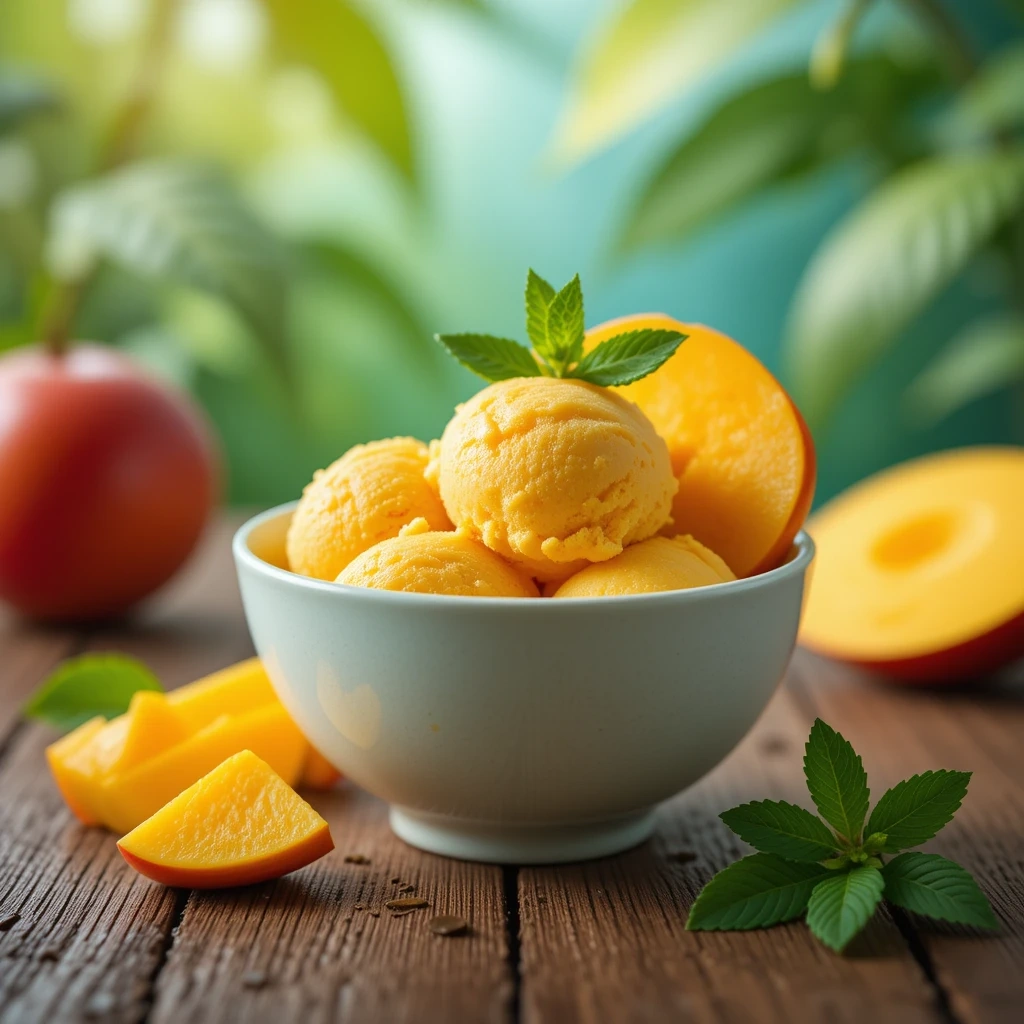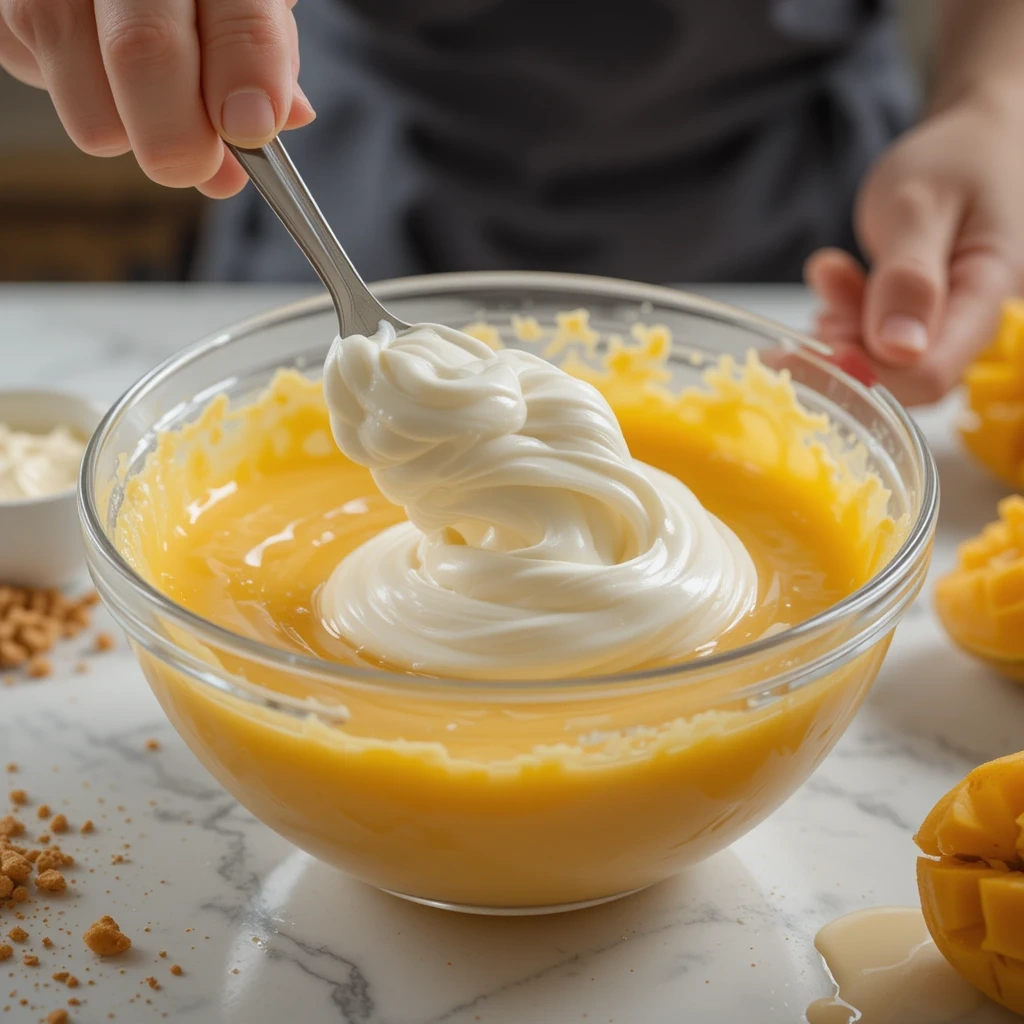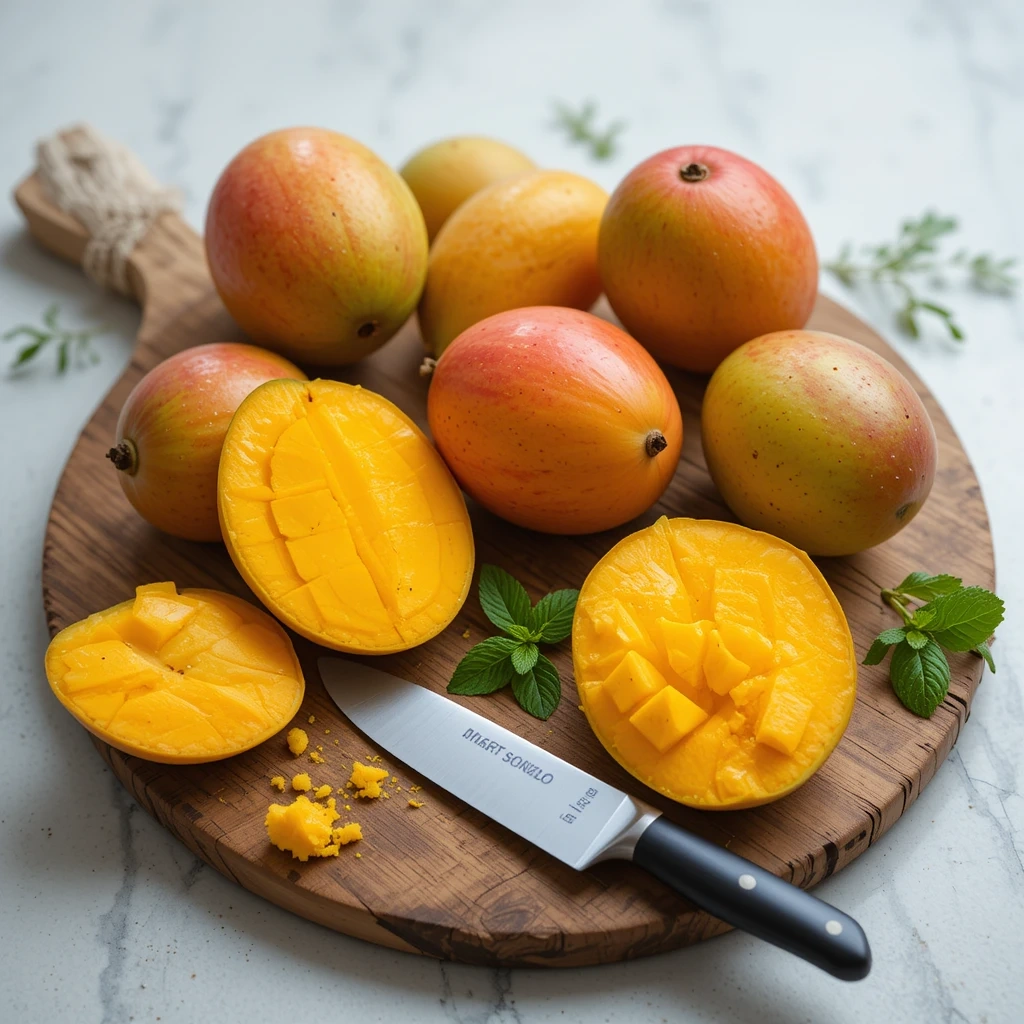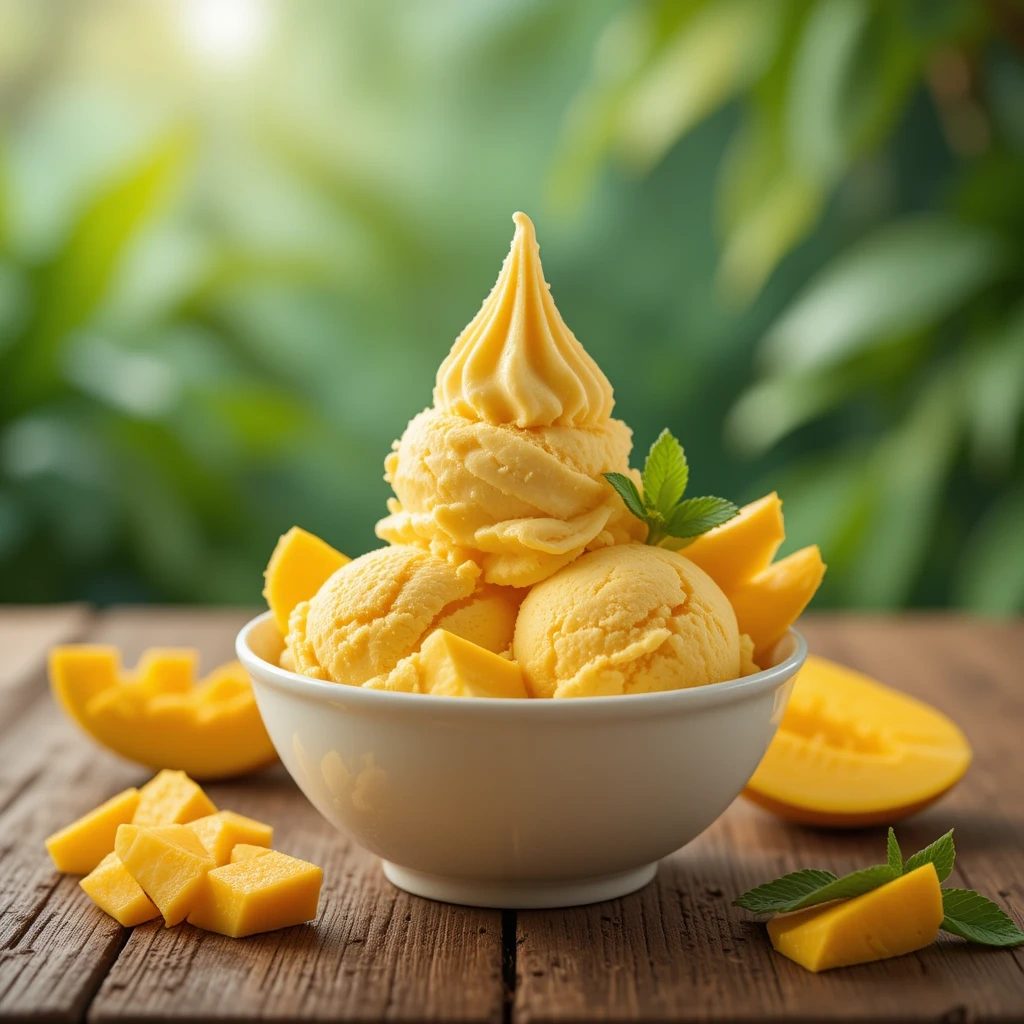I’ll never forget the first time I tasted a perfectly ripe Alphonso mango. It was during a summer visit to my aunt’s house in Florida, where she had a small but thriving mango tree in her backyard. The sweet, floral aroma filled the entire kitchen as she sliced into the golden flesh, juice running down her fingers. “This,” she declared with absolute certainty, “is nature’s perfect dessert.”

Years later, when I found myself with an abundance of perfectly ripe mangoes and a craving for something cold and creamy, I remembered my aunt’s words. But I wanted to transform that “perfect dessert” into something even more magical—homemade ice cream. The only problem? I didn’t own an ice cream maker, and my previous attempts at no-churn ice cream had resulted in icy, crystallized disappointments that bore little resemblance to the smooth, creamy texture I was craving.
That’s when I discovered the magic of this 3-ingredient mango ice cream recipe. It’s revolutionized my summer dessert game, and I’m thrilled to share it with you today.
Why You’ll Love This Recipe
•Just 3 simple ingredients – No additives, stabilizers, or artificial flavors
•No ice cream maker required – Perfect for those without specialized equipment
•Incredibly creamy texture – No icy crystals, just smooth perfection
•Pure mango flavor – The tropical taste you can’t find in store-bought versions
•Make-ahead friendly – Prepare it days before you need it
The Secret to Perfect No-Churn Ice Cream
My journey to perfecting no-churn ice cream has been filled with both triumphs and failures. I’ve learned that the key to achieving that creamy, scoopable texture without an ice cream maker lies in understanding the science behind ice cream.
Traditional ice cream machines work by constantly churning the mixture as it freezes, which serves two important purposes: it incorporates air (creating a light, fluffy texture) and it prevents large ice crystals from forming (ensuring smoothness). Without a machine, we need to find alternative methods to achieve these same results.
The combination of sweetened condensed milk and whipped cream is truly magical in this regard. The condensed milk contains sugar and milk proteins that lower the freezing point of the mixture, preventing it from becoming rock-hard in the freezer. Meanwhile, the whipped cream introduces air into the mixture, mimicking the churning process of an ice cream machine.
When it comes to adding fruit like mango, there’s an additional challenge: fruit contains water, which can form ice crystals during freezing. The solution? Reducing the water content by concentrating the mango puree. This intensifies the flavor while ensuring a creamy final product.
Ingredients
•1 kg (about 2.2 lbs) ripe mango chunks (from approximately 3-4 large mangoes)
•1 can (395g/14 oz) sweetened condensed milk
•500 ml (2 cups) heavy whipping cream (cold)
•1/2 teaspoon vanilla extract (optional)
Kitchen Tools
•Blender or food processor
•Large mixing bowls
•Electric mixer or whisk
•Rubber spatula
•Loaf pan or freezer-safe container
•Parchment paper
Instructions
Step 1: Prepare the Mango Puree
1.Select perfectly ripe mangoes—they should yield slightly to gentle pressure and have a sweet, fragrant aroma.
2.Peel and dice the mangoes, removing all flesh from the pit.
3.Place the mango chunks in a blender or food processor.
4.Blend until completely smooth, with no chunks remaining.
5.Measure out 2 cups of mango puree (you may have extra, which is delicious stirred into yogurt!).
Step 2: Concentrate the Mango Flavor (Optional but Recommended)
1.Pour the mango puree into a non-stick skillet or saucepan.
2.Cook over medium-low heat, stirring constantly to prevent burning.
3.Simmer for 8-10 minutes until the puree has reduced by about half.
4.You’ll know it’s ready when you can drag a spoon through the puree and it leaves a clear path for a moment before filling in.
5.Remove from heat and cool completely before proceeding.
Step 3: Prepare the Base
1.In a large bowl, combine the cooled mango puree and sweetened condensed milk.
2.Add vanilla extract if using.
3.Whisk until thoroughly combined.
4.The mixture should be thick, smooth, and a beautiful golden-orange color.
Step 4: Whip the Cream
1.In a separate large bowl, pour the cold heavy whipping cream.
2.Using an electric mixer or a whisk (and some arm strength!), beat the cream until stiff peaks form.
3.Be careful not to overwhip—the cream should hold its shape when the beater is lifted but still look smooth, not grainy.
Step 5: Combine and Fold

1.Add about one-third of the whipped cream to the mango mixture.
2.Gently fold it in using a rubber spatula, moving from the bottom of the bowl upward and turning the bowl as you go.
3.This first addition lightens the mango mixture, making it easier to fold in the remaining cream.
4.Add the remaining whipped cream and continue folding gently until no streaks remain.
5.The goal is to maintain as much air in the mixture as possible, so be patient and gentle.
Step 6: Freeze
1.Pour the mixture into a loaf pan or freezer-safe container.
2.Smooth the top with your spatula.
3.Press a piece of parchment paper directly onto the surface of the ice cream to prevent ice crystals from forming.
4.Cover with a lid or aluminum foil for extra protection.
5.Freeze for at least 6 hours, preferably overnight.
The Art and Science of Perfect Mango Ice Cream
Selecting the Perfect Mangoes
The quality of your mangoes will directly impact the flavor of your ice cream. I’ve made this recipe with various mango varieties, and while all produce delicious results, there are some differences worth noting:
•Alphonso mangoes offer an intensely sweet, almost perfumed flavor that makes for an exceptional ice cream.

•Ataulfo (honey) mangoes are readily available in most grocery stores and provide a smooth, fiber-free puree with excellent flavor.
•Kent or Tommy Atkins mangoes work well too, though they may have more fibers that need to be strained out after blending.
Whatever variety you choose, ensure they’re fully ripe. An underripe mango will lack sweetness and that distinctive tropical flavor we’re aiming for.
The Concentration Technique
I discovered the concentration technique after my first attempt at mango ice cream turned out slightly icy. While researching solutions, I learned that reducing the water content in fruit purees can significantly improve the texture of the final ice cream.
When you simmer the mango puree, something magical happens: the water evaporates, concentrating both the flavor and the natural sugars. The result is a more intense mango flavor and a smoother texture in the finished ice cream.
If you’re short on time, you can skip this step, but I highly recommend taking the extra 10 minutes—the difference in flavor and texture is remarkable.
The Folding Technique
The way you combine the whipped cream with the mango mixture can make or break your ice cream. Folding, rather than stirring, preserves the air bubbles in the whipped cream, which are essential for a light, creamy texture.
I learned this technique from my grandmother, who was a master at making soufflés. She taught me to slide the spatula down the side of the bowl, across the bottom, and up the opposite side, turning the bowl slightly with each fold. It takes a bit of practice, but once you get the hang of it, you’ll use this technique for all sorts of delicate mixtures.
Pro Tips for Perfect Results
Temperature Matters
For the creamiest results, make sure your heavy cream is very cold before whipping. I even chill my mixing bowl and beaters in the freezer for about 15 minutes before starting.
Conversely, your mango puree should be completely cooled before combining it with the condensed milk and cream. Warm puree can deflate the whipped cream and lead to a denser final product.
The Parchment Paper Trick
Pressing parchment paper directly onto the surface of the ice cream before freezing is a game-changer. This simple step prevents air exposure, which is the primary cause of ice crystal formation. I learned this trick from a professional pastry chef, and it’s made a significant difference in the quality of my homemade frozen desserts.
Serving Suggestions
For the best scooping experience, remove the ice cream from the freezer about 5 minutes before serving. This allows it to soften slightly, resulting in smoother, rounder scoops.
I love serving this mango ice cream in:
•Waffle cones for a classic presentation
•Coconut halves for a tropical touch
•Between two thin ginger cookies for an elegant ice cream sandwich
•Alongside fresh berries for a colorful dessert plate
•Drizzled with a touch of honey and sprinkled with toasted coconut
Creative Variations
While the classic version is divine on its own, I’ve experimented with several variations that are equally delightful:
•Mango-Coconut: Replace 1/4 cup of the heavy cream with coconut cream and add 1/4 cup toasted coconut flakes before freezing.
•Mango-Lime: Add the zest and juice of one lime to the mango puree for a tangy twist.
•Spiced Mango: Add 1/2 teaspoon of cardamom or 1/4 teaspoon of saffron to the mango puree for an Indian-inspired flavor.
•Mango-Passion Fruit: Fold in the pulp of 2-3 passion fruits just before freezing for an extra tropical punch.
•Mango-Chili: Add a pinch of cayenne or chili powder to the mango puree for a sweet-heat combination that’s surprisingly refreshing.
Common Mistakes to Avoid
Over the years, I’ve made plenty of mistakes with this recipe. Let me save you the trouble by sharing what NOT to do:
1. Using underripe mangoes
Underripe mangoes lack both sweetness and flavor. If your mangoes aren’t quite ripe, place them in a paper bag with a banana for a day or two to speed up the ripening process.
2. Skipping the cooling step
Adding warm mango puree to whipped cream will cause it to deflate, resulting in a dense, less creamy ice cream.
3. Stirring vigorously instead of folding
Gentle folding preserves the air bubbles in the whipped cream, which are essential for a light texture.
4. Overwhipping the cream
If you whip the cream until it looks grainy or curdled, it’s gone too far. It should form stiff peaks but still look smooth and glossy.
5. Not using parchment paper
This simple step prevents ice crystals from forming on the surface of your ice cream.
Frequently Asked Questions
How long will this ice cream keep in the freezer?
For best quality, enjoy within 2 weeks. Always store with parchment paper pressed against the surface to prevent ice crystals.
Can I use frozen mangoes?
Yes! Thaw them completely first and drain any excess liquid before blending. You may need to reduce the puree a bit longer to concentrate the flavor.
Why is my ice cream too hard to scoop?
Homemade ice cream without commercial stabilizers will freeze harder than store-bought. Allow it to sit at room temperature for 5-10 minutes before serving for the perfect scooping consistency.
Can I make this recipe dairy-free?
Yes! Substitute the heavy cream with full-fat coconut cream and use sweetened condensed coconut milk instead of regular condensed milk.
Do I really need to reduce the mango puree?
While not absolutely necessary, reducing the puree concentrates the flavor and improves the texture by removing excess water. I highly recommend not skipping this step.
Can I use other fruits with this method?
Absolutely! This method works beautifully with strawberries, peaches, and even bananas. Just be sure to adjust the reduction time based on the water content of the fruit.
A Sweet Legacy
This mango ice cream recipe has become something of a signature dish in my family. I first made it for my aunt—the one with the mango tree—during a summer visit several years ago. She took one bite, closed her eyes, and declared it even better than fresh mangoes alone, which, coming from her, was the highest possible praise.
Now, whenever mango season arrives, friends and family start dropping hints about when I’ll be making my “famous” mango ice cream. I’ve taught the recipe to my nieces and nephews during summer cooking sessions, watching their amazement as simple ingredients transform into something so delicious.
What I love most about this recipe is how it captures the essence of summer in each spoonful. The vibrant flavor of perfectly ripe mangoes, preserved in a creamy, scoopable form that can be enjoyed anytime. It’s sunshine in a bowl, a tropical vacation for your taste buds, and proof that sometimes the simplest recipes are the most extraordinary.
I hope this 3-ingredient mango ice cream brings as much joy to your kitchen as it has to mine. Happy freezing!

